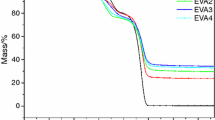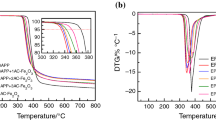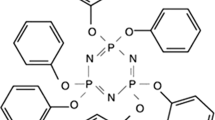Abstract
A series of flame-retardant ethylene–vinyl acetate (EVA) composites with different contents of aluminum phosphate (AHP) and Trimer were prepared. The synergistic flame-retardant effects of the Trimer with AHP in EVA/AHP blends were studied by limiting oxygen index (LOI) tests, UL-94 tests, cone calorimeter tests, thermogravimetric analysis, and scanning electron microscopy (SEM). The LOI and UL-94 results showed that the system containing AHP and Trimer was very effective in improving the flame retardancy of EVA. When the mass ratio of AHP and Trimer was 3:1, the highest flame retardancy could be obtained, and when the flame-retardant loading was 30 wt%, the EVA/AHP/Trimer (7.5%) sample could achieve the V-0 rating in UL-94 tests, at the same time, its LOI value was 24.4%. The TG and DTG results showed that the addition of flame retardants catalyzes EVA decomposition in the first stage and generates a more stable char residue in the second stage. Consequently, an efficient reduction in the flammability parameters, such as heat release rate, total heat release, smoke production rate, and total smoke production could be observed. In addition, it was observed from the SEM observations of the morphological features that the AHP and Trimer combination, at the optimum proportion, could promote the formation of compact charred layers and prevent their cracking, which effectively protected the underlying materials from burning.








Similar content being viewed by others
REFERENCES
Zhang F, Sun WY, Wang Y, Liu BS. Influence of the pentaerythritol phosphate melamine salt content on the combustion and thermal decomposition process of intumescent flame-retardant ethylene-vinyl acetate copolymer composites. J Appl Polym Sci. 2015;132(26):42148.
Lu K, Ye LJ, Liang QS, Li YJ. Selectively located aluminum hydroxide in rubber phase in a TPV: towards to a halogen-free flame retardant thermoplastic elastomer with ultrahigh flexibility. Polym Compos. 2015;36(7):1258–65.
Huang HH, Tian M, Liu L, Liang WL, Zhang LQ. Effect of particle size on flame retardancy of Mg(OH)2-filled ethylene vinyl acetate copolymer composites. J Appl Polym Sci. 2006;100(6):4461–9.
Lv J, Qiu LZ, Qu BJ. Controlled synthesis of magnesium hydroxide nanoparticles with different morphological structures and related properties in flame retardant ethylene-vinyl acetate blends. Nanotechnology. 2004;15(11):1576–81.
Fu MZ, Qu BJ. Synergistic flame retardant mechanism of fumed silica in ethylene-vinyl acetate/magnesium hydroxide blends. Polym Degrad Stab. 2004;85(1):633–9.
Huang NH, Chen ZJ, Yi CH, Wang JQ. Synergistic flame retardant effects between sepiolite and magnesium hydroxide in ethylene–vinyl acetate (EVA) matrix. Express Polym Lett. 2010;4(4):227–33.
Ahamad A, Patil CB, Mahulikar PP, Hundiwale DG, Gite VV. Studies on the flame retardant, mechanical and thermal properties of ternary magnesium hydroxide/clay/EVA nanocomposites. J Elastom Plast. 2012;44(3):251–61.
Laoutid F, Lorgouilloux M, Lesueur D, Bonnaud L, Dubois P. Calcium-based hydrated minerals: promising halogen-free flame retardant and fire resistant additives for polyethylene and ethylene vinyl acetate copolymers. Polym Degrad Stab. 2013;98(9):1617–25.
Li L, Qian Y, Jiao CM. Synergistic flame retardant effects of ammonium polyphosphate in ethylene-vinyl acetate/layered double hydroxides composites. Polym Eng Sci. 2014;54(4):766–76.
Wang DY, Cai XX, Qu MH, Liu Y, Wang JS, Wang YZ. Preparation and flammability of a novel intumescent flame-retardant poly(ethylene-co-vinyl acetate) system. Polym Degrad Stab. 2008;93(12):2186–92.
Alongi J, Poskovic M, Frache A, Trotta F. Novel flame retardants containing cyclodextrin nanosponges and phosphorus compounds to enhance EVA combustion properties. Polym Degrad Stab. 2010;95(10):2093–100.
Wang XS, Pang HC, Chen WD, Lin Y, Ning GL. Nanoengineering core/shell structured brucite@polyphosphate@amine hybrid system for enhanced flame retardant properties. Polym Degrad Stab. 2013;98(12):2609–16.
Liu Y, Fang ZP. Combination of montmorillonite and a Schiff-base polyphosphate ester to improve the flame retardancy of ethylene-vinyl acetate copolymer. J Polym Eng. 2015;35(5):443–9.
Qu HQ, Liu X, Xu JZ, Ma HY, Jiao YH, Xie JX. Investigation on thermal degradation of poly(1,4-butylene terephthalate) filled with aluminum hypophosphite and Trimer by thermogravimetric analysis–Fourier transform infrared spectroscopy and thermogravimetric analysis–mass spectrometry. Ind Eng Chem Res. 2014;53(20):8476–83.
Liu X, Wang JY, Yang XM, Wang YL, Hao JW. Application of TG/FTIR TG/MS and cone calorimetry to understand flame retardancy and catalytic charring mechanism of boron phosphate in flame-retardant PUR–PIR foams. J Therm Anal Calorim. 2017;130(3):1817–27.
Yang W, Hong NN, Song L, Hu Y. Studies on mechanical properties, thermal degradation, and combustion behaviors of poly(1,4-butylene terephthalate)/glass fiber/cerium hypophosphite composites. Ind Eng Chem Res. 2012;51(24):8253–61.
Zhao B, Hu Z, Chen L, Liu Y. A phosphorus-containing inorganic compound as an effective flame retardant for glass-fiber-reinforced polyamide 6. J Appl Polym Sci. 2011;119(4):2379–85.
Yang W, Tang G, Song L, Hu Y. Effect of rare earth hypophosphite and melamine cyanurate on fire performance of glass-fiber reinforced poly(1,4-butylene terephthalate) composites. Thermochim Acta. 2011;526(1–2):185–91.
Yang W, Yuen RKK, Hu Y, Lu HD. Development and characterization of fire retarded glass-fiber reinforced poly(1,4-butylene terephthalate) composites based on a novel flame retardant system. Ind Eng Chem Res. 2011;50(21):11975–81.
Tang G, Wang X, Xing WY, Zhang P. Thermal degradation and flame retardance of biobased polylactide composites based on aluminum hypophosphite. Ind Eng Chem Res. 2012;51(37):12009–16.
Jiang W, Hao J, Han Z. Study on the thermal degradation of mixtures of ammonium polyphosphate and a novel caged bicyclic phosphate and their flame retardant effect in polypropylene. Polym Degrad Stab. 2012;97(4):632–7.
Zhuo JL, Xie LB, Liu GD, Chen XL, Wang YG. The synergistic effect of hollow glass microsphere in intumescent flame-retardant epoxy resin. J Therm Anal Calorim. 2017;129(1):357–66.
Chen XL, Li M, Zhuo JL, Ma CY. Influence of Fe2O3 on smoke suppression and thermal degradation properties in intumescent flame-retardant silicone rubber. J Therm Anal Calorim. 2016;123(1):439–48.
Pike RD, Starnes WH, Jeng JP, Bryant WS, Kourtesis P, Adams CW. Low-valent metals as reductive cross-linking agents: a new strategy for smoke suppression of poly(vinylchloride). Macromolecules. 1997;30(22):6957–65.
Zhang J, Ji KJ, Xia YZ. Polymer combustion and flame retardant technology. Beijing: Chemical Industry Press; 2005. p. 130–2.
Feng J, Hao JW, Du JX, Yang RJ. Using TGA/FTIR TGA/MS and cone calorimetry to understand thermal degradation and flame retardancy mechanism of polycarbonate filled with solid bisphenol A bis(diphenyl phosphate) and montmorillonite. Polym Degrad Stab. 2012;97(4):605–14.
Acknowledgements
The work was financially supported by the Natural Science Foundation of China (Grant Nos. 21306035 and 21276059) and the Key Basic Research Project of Hebei Province (Grant No. 16961402D).
Author information
Authors and Affiliations
Corresponding author
Additional information
Jianzhong Xu’s contribution to the article is equivalent to the correspondence author.
Rights and permissions
About this article
Cite this article
Yang, G., Wu, W., Dong, H. et al. Synergistic flame-retardant effects of aluminum phosphate and Trimer in ethylene–vinyl acetate composites. J Therm Anal Calorim 132, 919–926 (2018). https://doi.org/10.1007/s10973-018-7026-0
Received:
Accepted:
Published:
Issue Date:
DOI: https://doi.org/10.1007/s10973-018-7026-0




